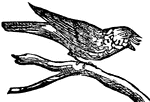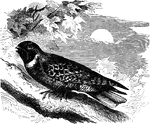Clipart tagged: ‘whip-poor-will’
![The Whip-poor-will or whippoorwill, Caprimulgus vociferus, is a medium-sized (22-27 cm) nightjar from North and Central America. The Whip-poor-will is commonly heard within its range, but less often seen. It is named onomatopoeically after its call. This bird is sometimes confused[1] with the related Chuck-will's-widow (Caprimulgus carolinensis) which has a similar but lower-pitched and slower call. Adults have mottled plumage: the upperparts are grey, black and brown; the lower parts are grey and black. They have a very short bill and a black throat. Males have a white patch below the throat and white tips on the outer tail feathers; in the female, these parts are light brown.](https://etc.usf.edu/clipart/57000/57013/57013_whippoorwill_mth.gif)
Whip-poor-will
The Whip-poor-will or whippoorwill, Caprimulgus vociferus, is a medium-sized (22-27 cm) nightjar from…

Whippoorwill
An American bird, allied to the nighthawk and nightjar, so called from its note, or the sounds of its…

Large Whippoorwill
"Antrostomus vociferus. Whippoorwill. Night-jar. Upper parts variegated with gray, black, whitish, and…

Small Whippoorwill
"Antrostomus vociferus. Whippoorwill. Night-jar. Upper parts variegated with gray, black, whitish, and…